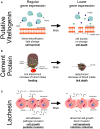Rhipicephalus bursa Sialotranscriptomic Response to Blood Feeding and Babesia ovis Infection: Identification of Candidate Protective Antigens
- PMID: 29780749
- PMCID: PMC5945973
- DOI: 10.3389/fcimb.2018.00116
Rhipicephalus bursa Sialotranscriptomic Response to Blood Feeding and Babesia ovis Infection: Identification of Candidate Protective Antigens
Abstract
Ticks are among the most prevalent blood-feeding arthropods, and they act as vectors and reservoirs for numerous pathogens. Sialotranscriptomic characterizations of tick responses to blood feeding and pathogen infections can offer new insights into the molecular interplay occurring at the tick-host-pathogen interface. In the present study, we aimed to identify and characterize Rhipicephalus bursa salivary gland (SG) genes that were differentially expressed in response to blood feeding and Babesia ovis infection. Our experimental approach consisted of RNA sequencing of SG from three different tick samples, fed-infected, fed-uninfected, and unfed-uninfected, for characterization and inter-comparison. Overall, 7,272 expressed sequence tags (ESTs) were constructed from unfed-uninfected, 13,819 ESTs from fed-uninfected, and 15,292 ESTs from fed-infected ticks. Two catalogs of transcripts that were differentially expressed in response to blood feeding and B. ovis infection were produced. Four genes coding for a putative vitellogenin-3, lachesin, a glycine rich protein, and a secreted cement protein were selected for RNA interference functional studies. A reduction of 92, 65, and 51% was observed in vitellogenin-3, secreted cement, and lachesin mRNA levels in SG, respectively. The vitellogenin-3 knockdown led to increased tick mortality, with 77% of ticks dying post-infestation. The reduction of the secreted cement protein-mRNA levels resulted in 46% of ticks being incapable of correctly attaching to the host and significantly lower female weights post-feeding in comparison to the control group. The lachesin knockdown resulted in a 70% reduction of the levels associated with B. ovis infection in R. bursa SG and 70% mortality. These results improved our understanding of the role of tick SG genes in Babesia infection/proliferation and tick feeding. Moreover, lachesin, vitellogenin-3, and secreted cement proteins were validated as candidate protective antigens for the development of novel tick and tick-borne disease control measures.
Keywords: Babesia spp.; RNA interference; Rhipicephalus bursa; sialotranscriptomics; vaccine; vector-pathogen interactions.
Figures






References
-
- Antunes S., Galindo R. C., Almazan C., Rudenko N., Golovchenko M., Grubhoffer L., et al. (2012). Functional genomics studies of Rhipicephalus (Boophilus) annulatus ticks in response to infection with the cattle protozoan parasite, Babesia bigemina. Int. J. Parasitol. 42, 187–195. 10.1016/j.ijpara.2011.12.003 - DOI - PubMed
Publication types
MeSH terms
Substances
LinkOut - more resources
Full Text Sources
Other Literature Sources
Medical
Miscellaneous

